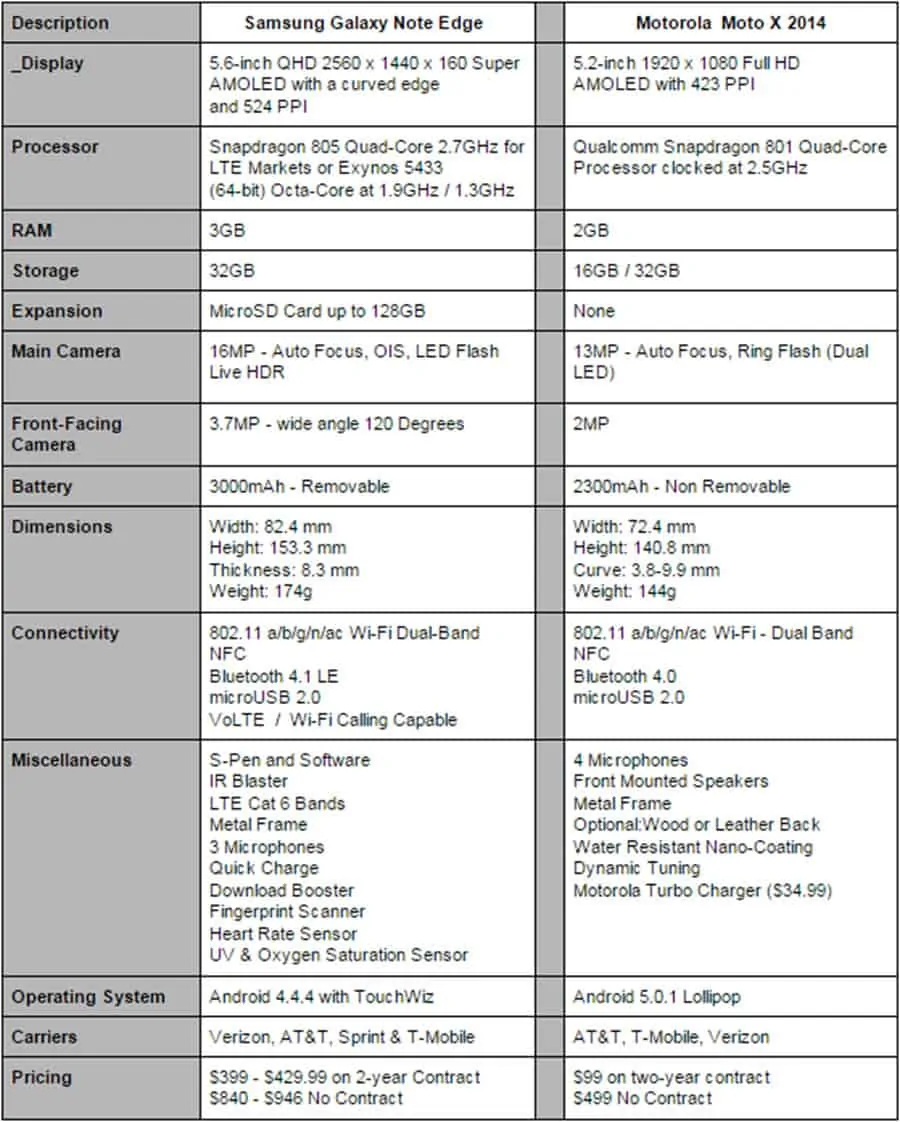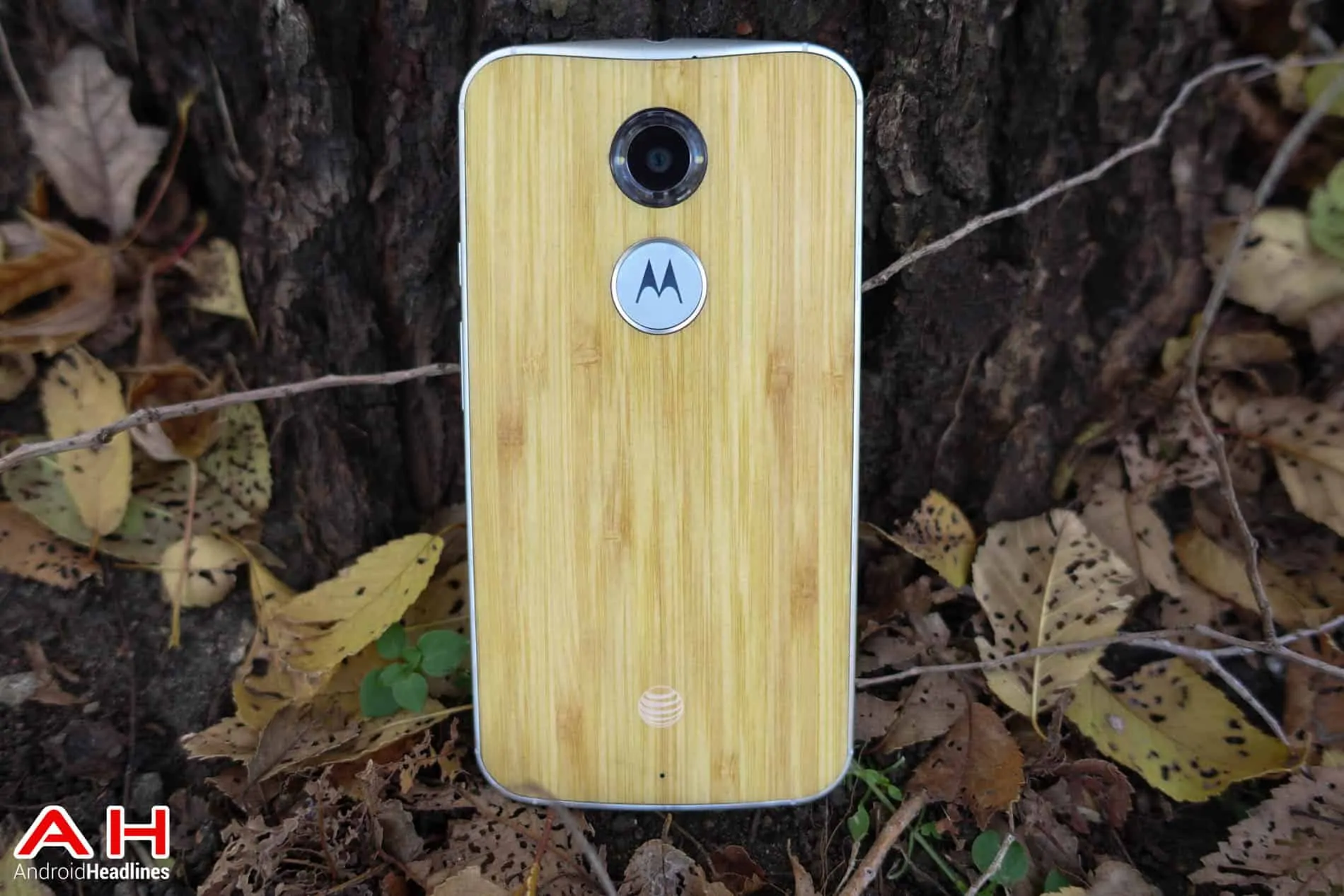Introduction
Do we have a good one for you today – the ‘bread and butter’ Motorola Moto X 2014 goes up against the new kid on the block, the Samsung Galaxy Note Edge. It is like the battle of David versus Goliath all over again…does David have enough in his ‘sling’ to bring down the Galaxy Note Edge. Let’s read on and find out just which one of these great devices will win this comparison.
Both devices are definitely targeting different audiences and there are not a whole lot of specifications in common between these two smartphones, but many of them are closed. They both use AMOLED technology for their displays, which are only one-half inch difference in size. They both use a Qualcomm Snapdragon processor, just a different model. They both have the usual Dual-Band Wi-Fi, NFC capability, Bluetooth, and a microUSB connector for charging and data transfer. However, at that point, these devices part company and each one has some benefits over the other.
Please look at the detailed Specifications chart below there you will be able to see exactly how they stack up against one another. After that, we will look at each individual device and raise some pros and cons to help make a decision for the winner of this comparison.
Specifications

Samsung Galaxy Note Edge
 When Samsung introduced the Galaxy Note Edge, it was to give users the chance to enjoy the usual Galaxy Note niceties – S-Pen, large display and a premium metal design – but also to add a touch of innovation with the curved display on the right hand side. It not only makes the Galaxy Note Edge look awesome, but it truly does add a real practical use for developers to create options, buttons or whatever they feel will add to their application.
When Samsung introduced the Galaxy Note Edge, it was to give users the chance to enjoy the usual Galaxy Note niceties – S-Pen, large display and a premium metal design – but also to add a touch of innovation with the curved display on the right hand side. It not only makes the Galaxy Note Edge look awesome, but it truly does add a real practical use for developers to create options, buttons or whatever they feel will add to their application.
The Galaxy Note Edge sports a 5.6-inch QHD Super AMOLED display with a resolution of 2560 x 1440 x 160 (the curved edge) and 524 PPI. The Moto X does use the AMOLED screen technology, but its FHD display and 423 pixels-per-inch (PPI) are not quite as sharp as the Galaxy Note Edge. The Note Edge (US version) uses the Qualcomm Snapdragon 805 quad-core processor clocked at 2.7GHz, while the Moto X is still using the older Snapdragon 801 quad-core clocked at 2.5GHz – both are great processors, but the 805 carries with it a few extra features and better graphics. The Galaxy Note Edge uses 3GB of RAM versus the 2GB found in the Moto X, although that extra 1GB is probably handling TouchWiz! The Note Edge also uses 32GB as standard internal storage with a microSD card slot for added expansion. The Moto X can be ordered with 32GB of storage, but has no way to expand it any further. The Galaxy Note Edge packs a 3000mAh sized battery – Samsung had to cut some away from the 3,220mAh battery found in the Galaxy Note 4 to accommodate the curved display – the Moto X has only a 2300mAh battery. Even with the difference in battery size, each device will see you through an entire day’s usage.
Samsung really improved the camera this time around by increasing the sensor to 16MP – with autofocus, an LED Flash, they finally added OIS, their own ISOCELL technology and the ability to take live HDR shots. Although the Moto X uses a slightly smaller 13MP sensor, it adds dual-LED Flash Ring the goes all the way around the outside edge of the lens and autofocus. The front-facing camera (FFC) on the Galaxy Note Edge is larger, at 3.7MP and with a wide-angled lens, you can fit more people in your selfies or video chat than the 2MP FFC on the Moto X.
The Galaxy Note Edge comes with many extras – it is VoLTE and Wi-Fi Calling capable, LTE Cat 6 (if you can find it), three microphones for noise cancellation and better sound, download booster, a fingerprint scanner, heart rate sensor and UV, Oxygen Saturation sensor and Samsung’s UPSM (Ultra Power Saving Mode.) Of course, the S-Pen and all of its software and its uses are enjoyed by the Galaxy Note Edge, as is the ‘Edge’ display for added functionality. The Note Edge is running Android 4.4.4 KitKat and is available on all four major US carriers. It will run you a steep $399 on a two-year contract and about $850 off-contract.
Motorola Moto X 2014
 The new Motorola Moto X 2014 is a great update of an old favorite of ours and many others. Motorola retained what we like best about the original Moto X, but improved it in all areas. They not only made the display larger – but also kept it at that sweet spot of 5.2-inches – but the internal specifications were upped to make it a device truly deserving of the term flagship. Motorola already has a Moto G and Moto E, but what they needed was for the Moto X to be a standout flagship to compete against the likes of the Galaxy S’s, LG G series and the HTC One series…and they have accomplished that task.
The new Motorola Moto X 2014 is a great update of an old favorite of ours and many others. Motorola retained what we like best about the original Moto X, but improved it in all areas. They not only made the display larger – but also kept it at that sweet spot of 5.2-inches – but the internal specifications were upped to make it a device truly deserving of the term flagship. Motorola already has a Moto G and Moto E, but what they needed was for the Moto X to be a standout flagship to compete against the likes of the Galaxy S’s, LG G series and the HTC One series…and they have accomplished that task.
The Moto X sports a 5.2-inch FHD AMOLED display with a resolution of 1920 x 1080 and a very respectable 423 PPI – not quite up to the QHD display and 524 PPI found on the Galaxy Note Edge – but beautiful none-the-less. Both devices use a 32-bit Qualcomm Snapdragon processor – the Moto X used the best one of its day…the 801 quad-core clocked at 2.5GHz…just a step below the 805 quad-core clocked at 2.7GHz in the Galaxy Note Edge. The Moto X uses 2GB of RAM versus the 3GB in the Galaxy Note Edge, although with the extra burden of TouchWiz versus the almost pure vanilla Android on the Moto X, this is really a wash. The Moto X offers internal storage of 16GB or 32GB with no room for expansion like the Galaxy Note Edge – Google and Motorola want you to store everything on the cloud, not your device.
In the camera area, the Moto X is a little ‘outclassed.’ It uses a 13MP sensor and a terrific dual-LED Flash Ring that encompasses the lens, along with autofocus…but no OIS. It also uses the rather pedestrian 2MP FFC for social media selfies and video chatting. Motorola never seemed to place a priority on its camera, but with the new Moto X, they at least come out swinging. It also has a small, 2300mAh battery, but getting through a day should not be problem, and when you do need to charge up your battery, you have access to the Motorola Turbo Charger (extra purchase) that will give you up to 6 hours of usage with only a 15-minute charge.
Besides the usual Dual-Band Wi-Fi, NFC capabilities, Bluetooth and microUSB connector, the Moto X does have a few things the Galaxy Note Edge does not have. The Moto X comes with four microphones for added noise reduction and great sound when speaking on the device. It also sports front mounted speakers for that in-your-face sound, optional wood or genuine leather back, nano-coating for water resistance, and a great feature called Dynamic Tuning that will automatically switch to the antenna with the best reception. It also sports Android 5.0.1 Lollipop and is now as low as $0 down on a two-year contract and $499 with no contract.
…And The Winner Is…

Summary
This is another decision based solely on two things – the first is that fact that the Moto X is first and foremost a solid device and should appeal to a large audience and secondly the fact that you can get one for FREE on a two-year contract…that is a $400 savings over the Galaxy Note Edge! If money was no object, I would pick the Galaxy Note Edge in a heartbeat (probably less) – it is superior in almost every way in specifications and functionality – but when it comes down to the nitty and the gritty, it is hard to pass up this bargain of a device called the Moto X.
The Galaxy Note Edge offers many impressive features (which I love), but does it offer the latest Android 5.0.1 Lollipop (and quick upgrades), four versus three microphones, does it offer front-facing speakers, does it offer the wood or real leather backing, water resistance, or Dynamic Tuning – the answer would be a big no. The Galaxy Note Edge does offer a better display and slightly better processor, although both devices are still using 32-bit, better camera, and the S-Pen (which I love) – but for $400 more it should boost some features. Probably my biggest gripe on the Moto X is the lack of a microSD card slot, as I like my data stored on my device, not floating up in the clouds.
Please hit us up on our Google+ Page and let us hear your choice and WHY…as always, we would love to hear from you.

